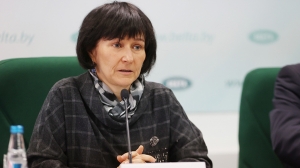IAEA's IPPAS mission expected to visit Belarus soon

OSTROVETS DISTRICT, 10 June (BelTA) – Belarus intends to welcome the International Atomic Energy Agency's International Physical Protection Advisory Service (IPPA) mission soon, BelTA learned from Olga Lugovskaya, Head of the Nuclear and Radiation Safety Department of the Belarusian Emergencies Ministry (Gosatomnadzor), on 10 June.
The official said that the system of missions offers a set of tools for the International Atomic Energy Agency to evaluate compliance with nuclear and radiation safety requirements. “Belarus has hosted a large number of missions. We've agreed to IAEA proposals and have requested some missions ourselves. In literally a couple of weeks we are going to welcome an International Physical Protection Advisory Service (IPPA) mission, which will evaluate the physical protection of nuclear materials. A post-mission of the Integrated Regulatory Review Service (IRRS) will take place in Q4 2021. It will evaluate the fulfillment of recommendations, which were issued in 2016,” Olga Lugovskaya said. In her words, Belarus also looks forward to a European peer review in late August.
Belarus voluntarily organized stress tests of the Belarusian nuclear power plant in line with the European Union's methods. The stress tests evaluated the availability of safety margins in excess of those required by the national legislation. Criteria of the stress tests included checking the nuclear power plant's resilience to natural phenomena, in particular, earthquakes and floods, as well as various man-made accidents. Apart from that, risks relating to the human factor were analyzed.
The national regulatory authority (Gosatomnadzor) used results of the stress tests to prepare a national action plan, which summarized both recommendations given as a result of a national expert evaluation and recommendations given by European peer review experts. The document contains 23 measures, which are supposed to be implemented in 2019-2025.
Key recommendations relating to additional safeguards and safety-enhancing equipment have already been fulfilled. For instance, a movable diesel generator has been delivered to the Belarusian nuclear power plant site. It will always be on standby and if necessary, it will keep safety systems of the first unit running. All the design solutions to install and connect the diesel power generator have been implemented. Similar solutions will be used at the second unit, too.
Apart from that, the replenishing of tanks for passive reactor heat dissipation systems has been successfully tested. These systems are designed to deal with accidents beyond the design basis and can siphon off residual heat from the reactor core via steam generators if the nuclear power plant experiences a total power outage. The necessary design solutions have been implemented as well.
The Belarusian nuclear power plant is being built near Ostrovets, Grodno Oblast using the Russian design AES-2006 featuring two VVER-1200 reactors with the total output capacity of 2,400MW.













